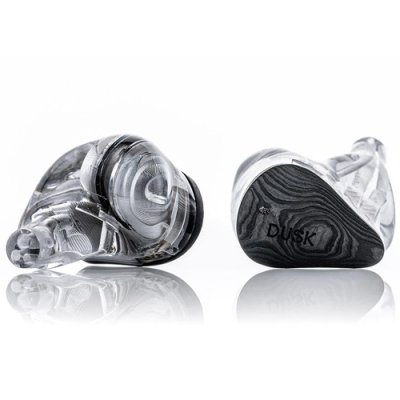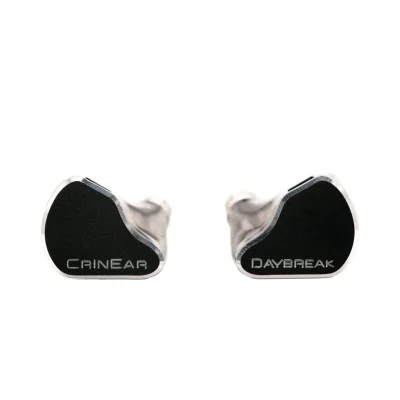Moondrop x Crinacle Dusk and Crinear Daybreak use 2DD+2BA+2PLA and 1DD+2BA+2mPT driver setups respectively. Moondrop x Crinacle Dusk costs $400 while Crinear Daybreak costs $170. Moondrop x Crinacle Dusk is $230 more expensive. Moondrop x Crinacle Dusk holds a slight 0.4-point edge in reviewer scores (7.7 vs 7.3). User ratings place Moondrop x Crinacle Dusk at 7.7 and Crinear Daybreak at 7.4. Crinear Daybreak has slightly better bass with a 0.3-point edge, Moondrop x Crinacle Dusk has significantly better treble with a 1.1-point edge, Crinear Daybreak has slightly better dynamics with a 0.4-point edge, Moondrop x Crinacle Dusk has better soundstage with a 0.5-point edge and Moondrop x Crinacle Dusk has slightly better details with a 0.4-point edge.
Insights
| Metric | Moondrop x Crinacle Dusk | Crinear Daybreak |
|---|---|---|
| Bass | 7.3 | 7.6 |
| Mids | 7.4 | 7.4 |
| Treble | 7.8 | 6.6 |
| Details | 8 | 7.7 |
| Soundstage | 7.5 | 7 |
| Imaging | 7.5 | 7.7 |
| Dynamics | 7 | 7.4 |
| Tonality | 7.5 | 7.5 |
| Technicalities | 8 | 6.9 |
Moondrop x Crinacle Dusk Aggregated Review Score
Average Reviewer Scores
Average Reviewer Score:
7.7Strongly Favorable
Crinear Daybreak Aggregated Review Score
Average Reviewer Scores
Average Reviewer Score:
7.3Generally Favorable
Reviews Comparison
Moondrop x Crinacle Dusk reviewed by Super* Review
Youtube Video Summary
The new Moondrop x Crinacle Dusk borrows the Blessing 3’s ergonomics and accessory spread—spring tips, a lightweight 3.5 mm cable, and a braided USB DSP cable—while switching to a tribrid driver array: 2DD for bass, 2BA for mids, and 2 micro-planars for treble. The shell is medium-large yet secure and comfortable, with a narrower nozzle than earlier Blessings and a cleaner faceplate design. The DSP cable can sweeten tonality, but there are caveats: occasional artifacts, spotty DAP compatibility, and an Android-only app with EQ limits (no tweaks below ~60 Hz or above ~10 kHz).
On the analog cable, tonality lands neutral and mid-centric with a tasteful sub-bass lift and slightly eased presence region—still a touch clinical, but now with added body and engagement. The star is the bass quality: tight, punchy, and tactile without masking the mids. Imaging/separation are clearly above average, and treble has better extension and metallic timbre than older Moondrops. Swapping to the DSP cable warms the mids and adds a bit of mid-bass punch (less brightness, richer tone), trading a hint of separation for extra smoothness.
Comparisons: vs OG Dusk, the new set’s bass is less blammy but higher quality, and the treble timbre is more realistic; vs Blessing 3, this is fuller, deeper, and less thin; vs Hype 4, stage width and bass quantity favor the Hype, but the Dusk keeps vocals cleaner and more balanced. DSP experiments show Blessing 3 + DSP can get very close to the Dusk’s FR, and even the budget Moondrop May narrows the gap—yet the Dusk still wins on bass tightness, treble refinement, and overall technical polish. As an analog IEM around $360, this is the one to beat—an easy 5/5.
Super* Review original ranking
Super* Review Youtube ChannelBuy Moondrop x Crinacle Dusk on Aliexpress
Ad
Price: $399
Buy Moondrop x Crinacle Dusk on Aliexpress
Crinear Daybreak reviewed by Super* Review
Youtube Video Summary
The CrinEar Daybreak lands at $170 as the second IEM from Crinacle, positioned as a more accessible follow-up to the limited-edition Meta. This tribrid features a single dynamic driver, two balanced armatures, and two micro planars handling the highs. The build includes compact, semi-custom dark smoky resin shells offering good stability and comfort, though the molding might be slightly aggressive for some. The included cable provides swappable terminations (3.5mm and 4.4mm) but is noted for being somewhat stiff and kink-prone. Accessories are solid for the price, including a leatherette case and multiple tip options, with the stock silicones recommended for optimal fit due to the slightly longer nozzle.
Sonically, the Daybreak delivers what the review calls the best tonal balance yet within the popular "new meta" tuning category. Its frequency response is described as exceptionally neutral and natural from the mid-bass upwards, creating a low-contrast, chill, and non-fatiguing listen with forward, textured vocals and non-existent sibilance. However, this comes with trade-offs: the bass lacks ultimate tightness and slam, and the treble exhibits a light, wispy quality (likened to cotton candy) that lacks some bite and definition. While technical performance like imaging is solid, it doesn't stand out as exceptional.
In direct comparisons with six competitors around $200 (including the Meta, Binary x Chopin, EPZ P50, Ziigaat Lush, Truthear Pure, and Kiwi Ears KE4), the Daybreak consistently ranked highest for tonality. It was praised as a modern benchmark for natural tuning at its price. However, it fell behind in bass physicality and treble incisiveness. Ultimately rated a strong four stars, the Daybreak is highlighted as an excellent choice for those prioritizing a refined, natural midrange and easy listening experience over sheer technical prowess or visceral impact, earning the label of a "modern-day Etymotic ER2XR" with far better comfort.
Super* Review original ranking
Super* Review Youtube ChannelBuy Crinear Daybreak on Linsoul
Ad
Price: $169.99
Buy Crinear Daybreak on Linsoul
Moondrop x Crinacle Dusk reviewed by Jaytiss
Youtube Video Summary
Build impresses out of the box: a premium case, a handsome semi-transparent shell that’s a touch larger than AFUL’s Magic One, a smaller nozzle, and excellent comfort—easy A+. The included DSP cable feels great, while the analog cable comes off a bit cheap for the price. Packaging and accessories sit at an average level overall.
In analog form, this is a Jekyll-and-Hyde situation. Channel matching is spot-on, but the presentation reads flat/neutral to a fault—solid, yet not especially competitive, fitting more a $150–$170 tier for raw value. Versus the original Blessing 2 Dusk, the new Dusk extends better up top with more air, but from bass through upper mids (to ~8 kHz) the older set still vocals better and feels more engaging; upgrading for the analog tuning alone isn’t advised. Alternatives like the PULA PA02 or CKLVX 1DD+4BA hit a similar, clean-neutral aim, while Gizaudio Chopin shows a smarter 5–6 kHz dip, livelier mids, and punchier bass at roughly half the price. Among Crin collabs, it’s clearly more refined than the Dioko, but not a slam-dunk over his other budget-minded sets.
The story flips with the DSP. Engaged, the Dusk becomes an easy recommendation: noticeably more balanced, resolving, and simply fun, earning a “perfect score for value” within the DSP lane. Caveats: Android support is the sweet spot; iPhone compatibility can be finicky, pushing some users to desktop—where manual EQ already exists. Still, the app is simple, the extra tunings are useful, and plug-and-play convenience (no dongle DAC dance) is a win. Bottom line: as an analog IEM, only “good” and overpriced; as a DSP IEM, genuinely excellent—highly worth it if the use case fits.
Jaytiss Youtube Channel
Crinear Daybreak reviewed by Jaytiss
Youtube Video Summary
The CrinEar Daybreak features a metal nozzle and metal faceplate with comfortable contours, though the fit is noted as a bit dainty and small. Isolation is practically non-existent, and the fit isn't particularly secure. The included cable looks nice and photographs well, featuring interchangeable terminations for versatility, but its chin slider moves too easily and isn't recommended for those needing a functional one. The case is deemed aesthetically pleasing and feels good, though not especially premium, magnetically shutting with adequate space.
Sonically, the Daybreak leans boring and somewhat sterile or dry. It offers nice bass and a lot of upper mids, which are done decently with a standard 3K peak. However, the combination of this upper-mid focus and an incisive peak around 8K contributes to a perceived harshness and sharpness, lacking in overall detail retrieval. Graph comparisons reveal its signature has significantly more upper mids and often more bass than competitors like the Moondrop Dusk or TruthEar Nova, resulting in a less engaging listen. Sets like the Defiant, Chopin, and Performer 7 are cited as more engaging alternatives at similar or lower prices, with the Defiant specifically recommended over the Daybreak. Even the Punch Audio martillo and Moondrop Meteor, sharing driver configurations, are considered more fun or better tuned.
Ultimately, the Daybreak is a solid A-minus IEM, well-packaged and a commendable first effort for the brand, but it's not hypeworthy or a benchmark. It lacks imagination and falls short against numerous compelling alternatives around its price point, such as the Performer 7, ZOS Defiant, Chopin, or discounted planar options like the Aether. While a good value, especially if found on sale via Linsoul or the used market, its piercing upper mids and failure to truly excel make it hard to fully recommend over the competition.
Jaytiss Youtube Channel
Moondrop x Crinacle Dusk reviewed by Audionotions
Crinear Daybreak reviewed by Audionotions
Moondrop x Crinacle Dusk reviewed by Jays Audio
Youtube Video Summary
Stock tuning lands in the safe-and-smooth lane: a gently warm balance with a slight treble emphasis, nothing egregious and nothing especially standout. It works well for J-pop/K-pop at mid volume thanks to tamed upper-mids that keep sibilance in check. The trade-off is softer, “vanilla” vocals that miss the last bit of extension, air, and micro-detail; turn it up for more presence and the treble gets spicy—not helped by unit variance that can throw a 16k peak. Cymbal detail is decent with minimal “planar timbre,” but it can get a touch sizzly.
Against the field, Dusk struggles to justify the premium. Truthear Nova plays the same all-rounder role for much less while feeling more open up top; want a bit more top-end than Nova, there’s the Chopin at ~$200. Hype 4 comes off as a more well-rounded Dusk—better low-end texture, a hint more vocal reach, and less sharpness—and Quintet delivers a similar idea for cheaper. Even with EQ in the mix, Blessing 3 can match or better the result (smoother treble, no channel imbalance). Net: the sound is good but not special, and the value calculus isn’t favorable.
The supposed differentiator—DSP—isn’t it. The app feels unstable (settings not applying, frequent crashes), Android-only for adjustments, and awkward with external DAC/amps where EQ may not pass through. There’s a minor noise floor between pauses. Of the presets, “Stock 3.5mm (Analog)” and Bass+ are the only keepers; “Stock USB” is warmer but needs more upper-mids, and the Diffuse Field Tilt lands awkwardly. Phone amps also bottleneck staging; better sources open it up—but then the DSP conflicts. Add in QC concerns, and the verdict is clear: a pleasant, inoffensive listen, yet overhyped and overpriced for what it delivers; a solid sub-$200 proposition, not at its current bracket.
Jays Audio Youtube Channel
Crinear Daybreak reviewed by Jays Audio
Youtube Video Summary
The CrinEar Daybreak offers a balanced, clean, and non-fatiguing sound signature, functioning effectively as an all-rounder. Every frequency region is solid, delivering a smooth presentation without harshness or overwhelming warmth. The bass provides a slight sub-bass rumble and integrates cleanly into the mids, avoiding bleed, though it lacks significant impact, slam, or deep texture. Similarly, the mid-range and vocals are well-separated and forward enough, free from congestion or odd timbre, but don't specialize. The treble has enough extension and air, avoiding darkness or excessive sharpness, but misses out on micro-detail, sparkle, and expansive staging. It’s a decent, inoffensive performer across the board, described aptly as a "very good vanilla ice cream cone".
Technically, the Daybreak is competitive but not class-leading. Sets like the Meta, Ziigaat Crescent, Kiwi Ears Astral, Simgot EM6L, or TruthEar Nova offer slightly better detail retrieval, imaging, and resolution. Its main challenge comes from remarkably similar competitors, particularly the EPZ P50 and SLIIVO SL224, which share nearly identical tuning, driver configurations, and technical performance around the same $160-$180 price point. The P50 leans slightly more vocal-centric, while the SL224 offers marginally better bass texture and treble detail (though costing more). If you already own either, the Daybreak becomes largely redundant. Against alternatives like the bassier, more dynamic Ziigaat Odyssey ($200), the Daybreak feels safer but less engaging at higher volumes. Compared to Harman-tuned sets like the Supermix 4, Chopin, or Nova, the Daybreak boasts fuller tonality and less fatigue but gives up some layering and detail.
Ultimately, the Daybreak is a competent, well-packaged all-rounder at $170, delivering a balanced and inoffensive listen suitable for any genre library. However, it fails to stand out uniquely in a crowded field. Its sound signature is replicated almost exactly by the existing P50 and SL224. While it earns a half recommendation as a solid option for those seeking a non-fatiguing all-rounder who *don't* own those twins, it's unlikely to become a favorite due to its lack of distinctive character. Value is decent, but alternatives offer more specialization or technical prowess for similar or lower cost.
Jays Audio Youtube Channel
Moondrop x Crinacle Dusk (more reviews)
Moondrop x Crinacle Dusk reviewed by Bad Guy Good Audio
Bad Guy Good Audio original ranking
Bad Guy Good Audio Youtube ChannelMoondrop x Crinacle Dusk reviewed by Kois Archive
Kois Archive Youtube Channel
Moondrop x Crinacle Dusk reviewed by Tim Tuned
Tim Tuned Youtube Channel
Moondrop x Crinacle Dusk reviewed by Gizaudio Axel
Gizaudio Axel original ranking
Gizaudio Axel Youtube ChannelMoondrop x Crinacle Dusk reviewed by Shuwa-T
Moondrop x Crinacle Dusk reviewed by
 Fresh Reviews
Fresh Reviews
Youtube Video Summary
Moondrop x Crinacle Dusk earns raves for music: a clean, textured, fast low end with real sub-bass punch that avoids bloat, a natural, resolving midrange for male/female vocals and instruments, and crisp, well-controlled treble that delivers cymbal air without harshness. The overall presentation feels well-rounded and technical enough to spar with sets far above its price, evoking “revisit the whole library” vibes. Build and comfort impress too—lightweight shell, transparent chassis with a wood-like carbon faceplate, and an ergonomic fit. Tip-rolling matters: Spring Tips add a touch of openness and air, while SpinFit W1 tightens stage and teases out more bass on the “fish-mouth” nozzle.
Accessories are solid: a standard 3.5 mm cable plus a USB-C DSP cable that’s great for Android/iPad on-the-go listening, though PC gaming revealed instability in some titles (stutters/freezes in Apex Legends and Call of Duty). Day to day, the cable’s braid resists tangles, and the included case/tips round out a tidy package.
For competitive play, performance is mixed. Imaging is good and the bass gives an immersive punch, but the stage skews intimate and heavy effects can mask subtle cues. In Apex Legends, verticality and depth perception suffer—overhead action blends at forehead level, distant slides/grass shuffles fade, and chaotic fights cause layering to mush before quickly recovering. Call of Duty shows similar trade-offs with aerial and fine details under bombardment, while Valorant fares best thanks to tighter maps and fewer simultaneous effects (though horizontal peeks and micro-depth could still be sharper). The takeaway: S-tier for music in this bracket and a fun, cinematic gamer, but not the most surgical pick for top-ranked competitive play.
Fresh Reviews original ranking
Fresh Reviews Youtube ChannelMoondrop x Crinacle Dusk reviewed by Head-Fi.org
Crinear Daybreak (more reviews)
Crinear Daybreak reviewed by Paul Wasabii
Youtube Video Summary
CrinEar DayBreak presents a balanced end-to-end tuning that shifts with power. At low volume it can read warm and soft, but when driven a bit harder the bass and treble rise to meet the mids, revealing clean impact, clear treble extension from the BA + microplaner stack, and a more open presentation. Vocals carry natural body from a lower-mid bump without being pushed unnaturally forward, so the overall character leans more versatile than strictly vocal-centric.
Versus Meta, DayBreak fixes the bass shelf and stretches upper energy for easier air, trading some midrange push for better layering and imaging. Compared with Odyssey, high-volume listening yields more space and separation; against vocal sets like Cadenza 4 or Zero Red, DayBreak gives up a bit of mid focus but wins on genre range, especially EDM. Not a sub-bass monster, yet the bass hits harder than the graph suggests, with cleaner texture and a healthier sub-to-mid-bass ratio. The only nit is a slightly energetic 2–5 kHz zone that some will prefer a dB lower.
Call it an unintentional banger: the treble is sloped enough to avoid glare while keeping drops vivid, letting big builds explode without turning sharp. For listeners who play a notch louder and want balanced energy at both ends with mids that stay natural, DayBreak delivers a satisfying hybrid package for the price.
Paul Wasabii Youtube Channel
Crinear Daybreak reviewed by Fox Told Me So
This is it.
Crinear Daybreak's tuning follows the New Meta family with two quirks: a dip at 400 Hz that slightly thins male vocals, and a dip around 8 kHz that smooths treble but softens cymbals/overtones. Otherwise it’s safe, balanced, and within preference bounds.
Bass has moderate body with audible rumble and quick decay, though slam could hit harder; Mids sit neutral, neither pushed nor recessed, keeping instruments evenly balanced; Treble rolls off smoothly—pleasant, but lacks the final lift that would open it up. Resolution is average for the price: clear layers but compressed depth, like a lasagna being pressed flat.
Within the $169 bracket, Daybreak is neutral, natural, and non-fatiguing—an easy daily driver.
Fox Told Me So original ranking
Fox Told Me So Youtube ChannelCrinear Daybreak reviewed by Z-Reviews
Youtube Video Summary
The Crinacle Daybreak is a technically excellent IEM that offers exceptional clarity and detail retrieval without being fatiguing. Its five-driver configuration delivers a cohesive and precise sound signature that is clean, flat, and incredibly balanced. The bass is present and punchy but never exaggerated, making it a perfect tool for studying music and hearing every nuance in a recording.
However, this precision comes at the cost of fun. The tuning is described as a little dry and somewhat intimate, lacking the expansive soundstage and flavorful character that makes other IEMs more engaging for pure enjoyment. While the build is solid with an acceptable cable and nice connectors, its looks are admittedly boring. It’s a perfectly cooked meal that follows the recipe without any surprises.
Ultimately, the Daybreak is a highly respected and much-loved IEM that fills a specific niche for a clean, reference-like sound. It’s a business suit of an IEM, but it wouldn't be the first choice for someone looking for a more exciting, fun, or "f***ed up" sound signature to get them moving. It commands respect for its technical merits, even if it isn't to everyone's personal taste.
Z-Reviews Youtube Channel
Crinear Daybreak reviewed by Web Search
The CrinEar Daybreak is a tri-brid IEM built around a 5-driver array—1DD + 2BA + 2 micro-planar tweeters—with a moderate 20 Ω load and 105 dB/mW sensitivity, making it easy to drive from portable sources. MSRP sits at $169.99, placing it squarely in the competitive mid-budget segment. These core specs are confirmed on the official product page and retail listings.
Tonally, Daybreak trends toward neutral with a mild sub-bass lift and restrained warmth, but listener experience can swing with tip choice. Multiple independent impressions note a touch of upper-mid / lower-treble energy (ear-gain region) on stock narrow-bore tips, which relaxes with wide-bore options; overall midrange balance and resolution are strong for the price. These observations are echoed in in-depth evaluations and measurements from Headphones.com’s reviews.
Build is a resin shell with metal faceplate and a compact pseudo-custom profile; comfort is generally good, though the 6 mm nozzle and angle may not be ideal for every ear. Accessory quality is serviceable—SPC cable with interchangeable 3.5 mm / 4.4 mm terminations, a leatherette case, and basic tips—leaving room for aftermarket tip rolling to fine-tune treble behavior and staging. These physical details and inclusions are documented by the maker and retailers.
Moondrop x Crinacle Dusk Details
Driver Configuration: 2DD+2BA+2PLA
Tuning Type: n/a
Brand: Moondrop Top Moondrop IEMs
Price (Msrp): $400
Support our free service! Buying through our affiliate links costs you nothing extra:
Crinear Daybreak Details
Driver Configuration: 1DD+2BA+2mPT
Tuning Type: Neutral with Bass Boost
Brand: CrinEar Top CrinEar IEMs
Price (Msrp): $169.99
Support our free service! Buying through our affiliate links costs you nothing extra:
Moondrop x Crinacle Dusk User Review Score
Average User Scores
Average User Score:
Based on 1 user reviews
7.7Strongly Favorable
Crinear Daybreak User Review Score
Average User Scores
Average User Score:
Based on 1 user reviews
7.4Generally Favorable
Moondrop x Crinacle Dusk Gaming Score

Gaming Score & Grade
- The gaming score is prioritizing technical capabilities of the IEM (Separation, Layering, Soundstage) and good value.
Gaming Score
7.6Gaming Grade
ACrinear Daybreak Gaming Score

Gaming Score & Grade
- The gaming score is prioritizing technical capabilities of the IEM (Separation, Layering, Soundstage) and good value.
Gaming Score
7.1Gaming Grade
A-Moondrop x Crinacle Dusk Scorings
Average Technical & Tuning Grades
Average Tunign Grade
A- You get a polished tonal profile that stays natural from bass through treble. Subtle tuning choices keep things engaging.
Average Technical Grade
A+- You get an articulate, polished performance with immersive stage depth and great control. There's a sense of polish across the whole spectrum.
Crinear Daybreak Scorings
Average Technical & Tuning Grades
Average Tunign Grade
A- Tuning lands in a pleasing sweet spot with mostly coherent frequency integration. Tonality stays consistent from track to track.
Average Technical Grade
B+- The presentation is steady if unspectacular, holding onto essential details when the music stays simple. Fine details occasionally slip through the cracks.
Moondrop x Crinacle Dusk User Reviews
Share your experience and build your personal ranking list.
You need to be signed in to write your own reviewMust use DSP default, much much better than analog
Pros
Very impressive across the board.Cons
Feels kinda "I don't want to hear them for a while" after long sessions. Not sure whyCrinear Daybreak User Reviews
Share your experience and build your personal ranking list.
You need to be signed in to write your own reviewA well-toned, easy-listening IEM that excels at midrange clarity even if it doesn’t dazzle technically.
Pros
Balanced and non-fatiguing tuning with smooth, natural mids.Cons
Bass lacks slam and treble can feel veiled or lacking crisp sparkle.Find your next IEM:
IEM Finder Quiz
newIEM Comparison Tool
newVS





























